A practical way of letting nature back in is through the activities of the Conservancy movement. There are nearly 100 Conservancies in KwaZulu-Natal, and in addition to their conservation work, many host activities enabling people to visit these special areas. For example, the Karkloof Conservancy in addition to hosting guided walks, has two bird hides in the wetland where three species of cranes may be seen.
As Conservancies KZN explains: “Conservancies are voluntary community organisations made up of people who care for the environment. There are many different types of Conservancies: urban, suburban, rural, farming, coastal, and even in residential estates, business parks and landfill sites!”. These Conservancies protect wildlife and eco-systems, and may also be involved in projects related to fresh water, waste management, recycling and renewable energy.
Working for Wetlands, a joint initiative of three South African government departments, reminds us that wetlands are high value eco-systems but that formerly they were regarded as wastelands to be converted for other uses. However, in more recent times the value of wetlands is better understood, but many wetlands globally have been lost. Studies in South Africa suggest that a high percentage of our wetlands have been lost or severely degraded with many of the remaining wetlands having little or no protection.
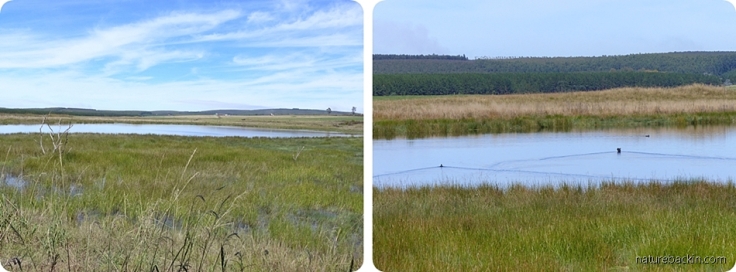
A protected wetland in the Karkloof Conservancy surrounded by farmland and timber plantations
Working for Wetlands points out that the loss of wetlands leads to serious consequences, including:
- Diminished water security,
- Desertification,
- Reduced food security,
- Reduction in biodiversity,
- Lost livelihoods and
- Increased vulnerability to natural disasters, especially floods and droughts.
With the extreme weather and changing rainfall patterns associated with climate change, the role of wetlands in reducing the impacts of floods and droughts is even more important.
Caring for and protecting wetlands is important for the protection of our water resources and for sustaining food production and is also crucial for enhancing biodiversity.
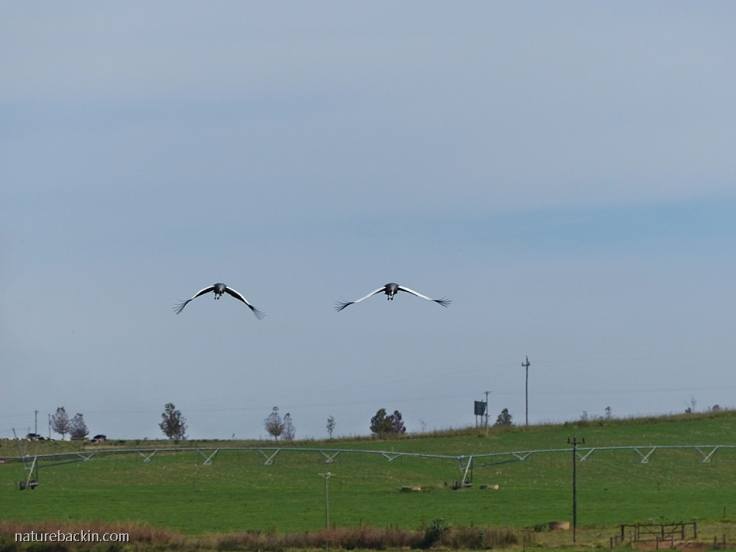
A pair of Grey Crowned Cranes flying in over the irrigation sprinkler system of a farm neighbouring the Conservancy wetland
One of the reasons why visiting wetlands is so rewarding is to see first-hand the variety of life that thrives in such an environment. Many managed wetlands provide sustainable opportunities for visitors to appreciate such rich ecosystems and to learn about their fundamental importance.
Wetlands can be managed and protected not only in “wild” places, but also in urban and agricultural contexts. I have heard of a farmer who, after giving up planting cash crops to focus on improving the health of the wetlands and streams on his farm, described what he was doing as “farming water”. I thought this was an interesting way of looking at it.
Not only do farmers benefit from wetland protection through having, for example, access to clean water for irrigation and the reduced soil erosion that wetlands provide, but also diverse species of plants and animals are able to thrive and breed in protected wetlands. Among the birds that depend on wetlands and surrounding natural grasslands are the three species of cranes that occur in South Africa. These three, namely, the Grey Crowned Crane, the Wattled Crane and the Blue Crane, can at times be seen at the Karkloof Conservation Centre near Howick in the KwaZulu-Natal Midlands.
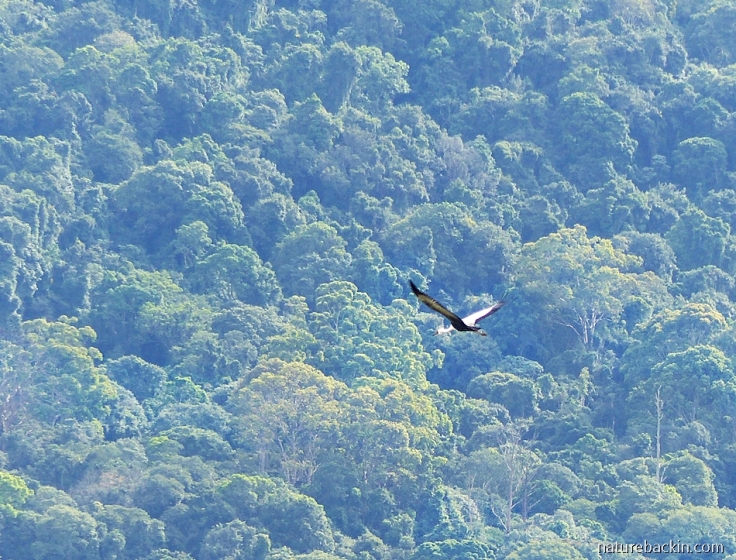
On one of our visits to the Karkloof Conservation Centre we were fortunate enough to see a pair of Wattled Cranes. I photographed this one flying with a glorious patch of mistbelt forest as a backdrop. The status of the Wattled Crane is listed as Vulnerable, on the IUCN Red List of Threatened Species
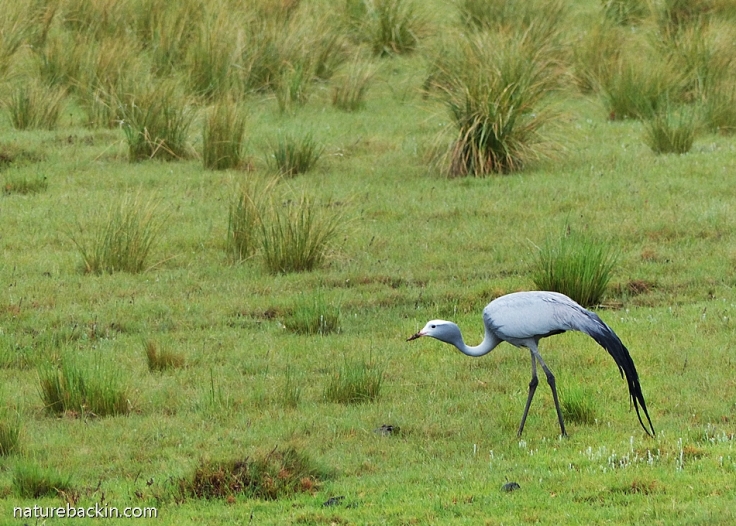
We have not yet been fortunate enough yet to see any Blue Cranes at Karkloof. This one I photographed one rainy day near Naudés Nek pass in the Eastern Cape. Blue Cranes, South Africa’s national bird, are endemic to Southern Africa, and although their population is regarded as stable, their status is listed as Vulnerable, on the IUCN Red List of Threatened Species
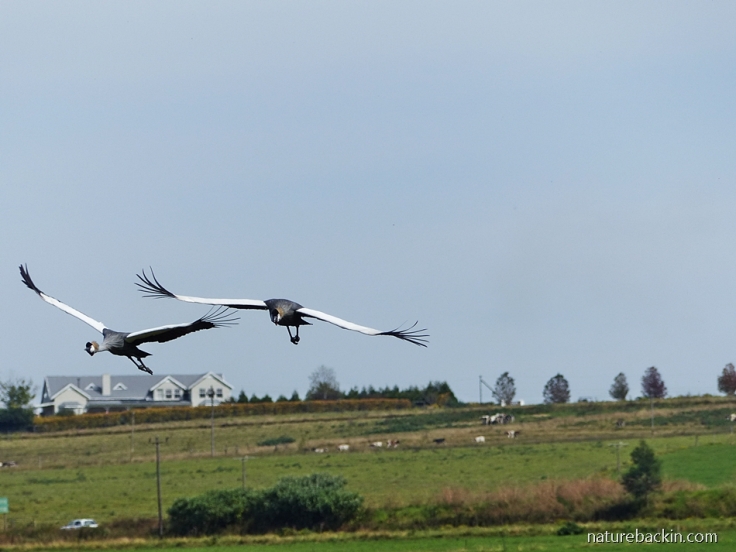
We had just got ourselves seated at the second bird hide at Karkloof Conservancy when this pair of Grey Crowned Cranes flew in. A neighbouring farmhouse can be seen in the background
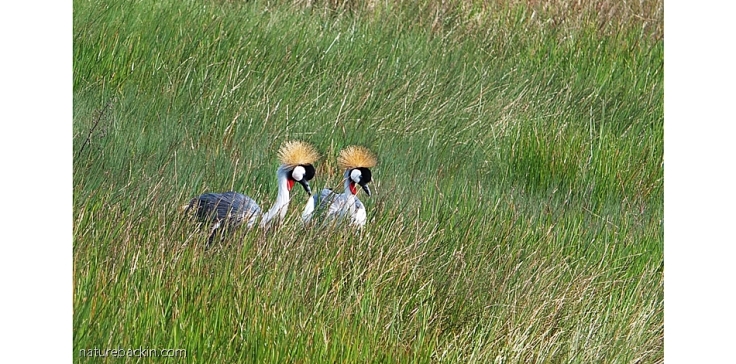
How fortunate to see a pair of these beautiful birds. Sadly, they are listed by the IUCN as being Endangered
The loss and degradation of wetlands and associated grasslands are one of the main reasons for the Vulnerable or Endangered status of cranes. There are other factors too that contribute to the decreasing numbers of Grey Crowned Cranes, and these include human disturbance, live capture of chicks and collection of eggs for commercial trade, unintentional or intentional poisoning, power line collisions and land development.
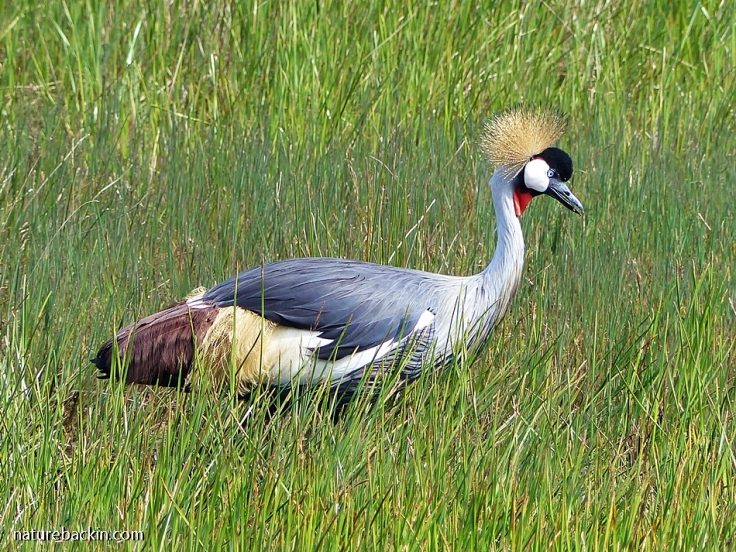
Grey Crowned Cranes can live up to 22 years in the wild. Adults weigh between 3 and 4 kg. These tall birds are 100 to 110 cm in length, with wingspans of 180 to 200 cm. They are the only species of Crane to have a long hind toe that enables them to perch in trees. They roost in trees at night to avoid predators, which include domestic dogs
Organisations working to protect cranes include the International Crane Foundation. Click here to read about the work that they do. Locally we have the KZN Crane Foundation. It notes that the population of Grey Crowned Cranes in South Africa is down to between 3000 and 4000 adult birds.
Grey Crowned Cranes are omnivorous in their feeding habits, with their diet consisting of the seed heads and tips of sedges and grasses, leaves, agricultural crops including pulses, nuts, grains and seedlings, insects and insect larvae, caterpillars and worms, frogs, lizards and crabs, and also rodents. Unfortunately, they can be regarded as a pest on farms as they may damage crops.
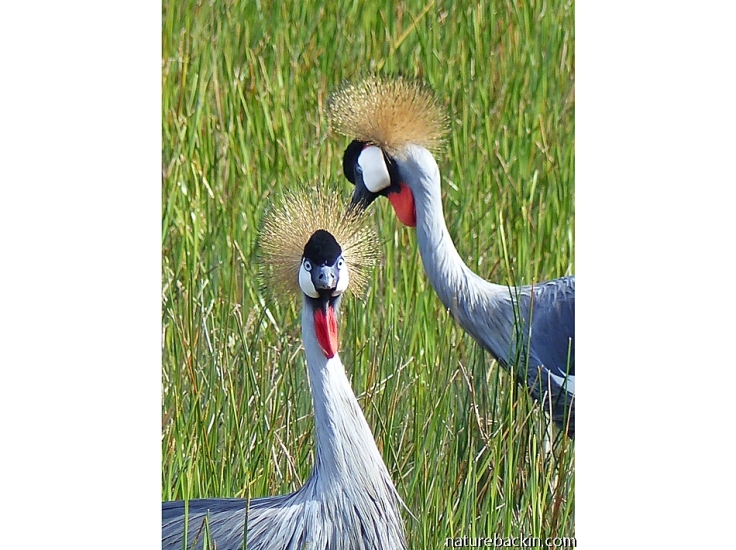
Grey Crowned Cranes form monogamous breeding pairs, often staying together for life. Breeding occurs usually in the wetter months and the nest is built either in standing water or near it where there is tall vegetation. They lay 2 to 4 eggs that are incubated for about a month. Hatchlings can float on water within 12 hours of hatching and fledglings can wander with their parents as early as their second day, returning to the nest at night
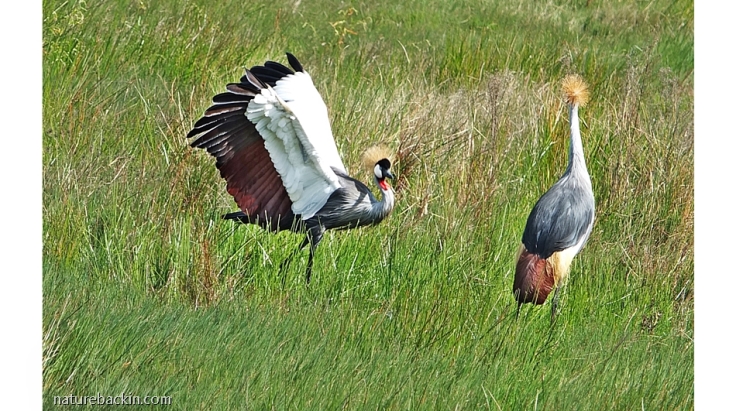
The courtship dance of cranes is well known. How amazing that shortly after arriving in front of the bird hide, this pair of cranes started calling and bobbing before embarking on a series of wing spreading and flapping, and jumping in the air. Either the male or the female may initiate such a display
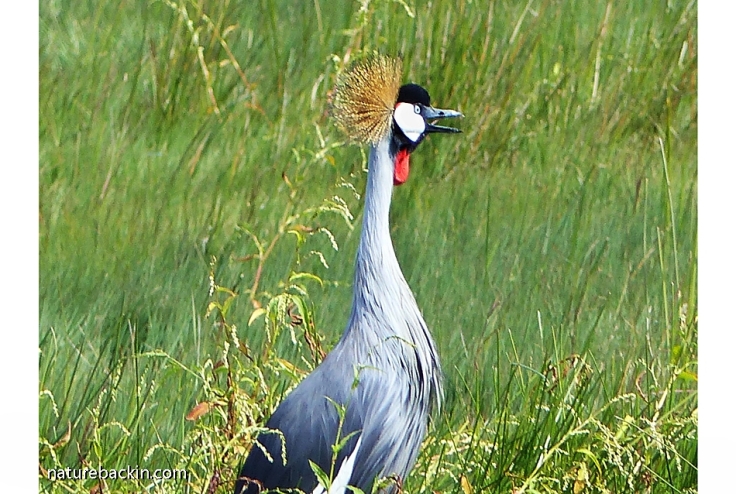
Usually the courtship “dance” starts with the pair duetting in a series of honking calls. The red throat sac is inflated to amplify the call
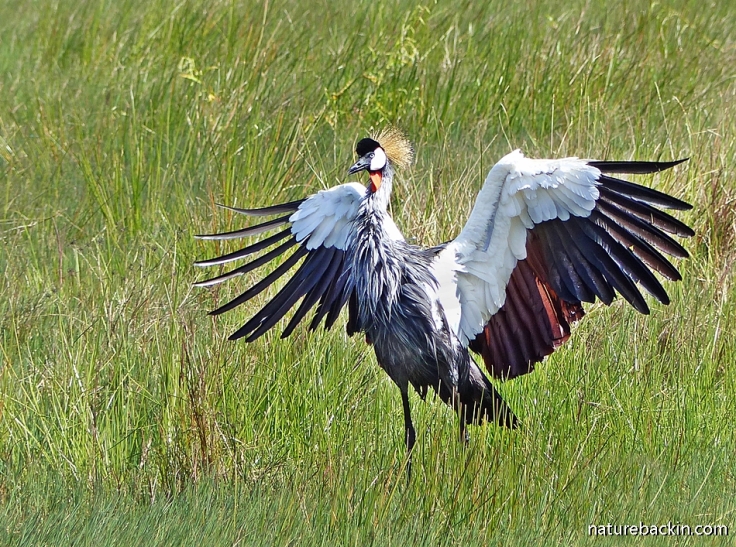
The crane is truly impressive with wings extended
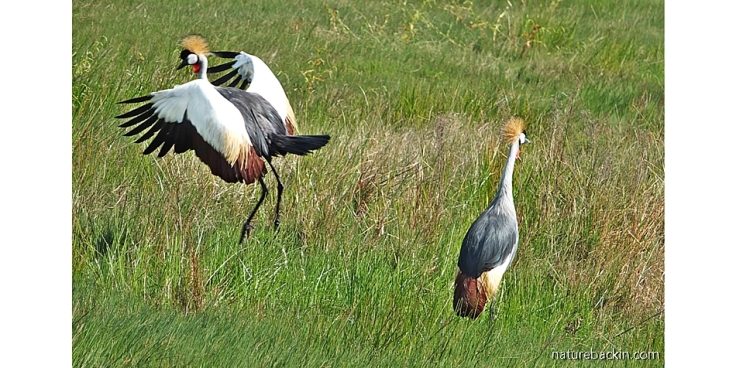
In addition to extending and flapping the wings, and bobbing up and down, jumping also forms part of the display
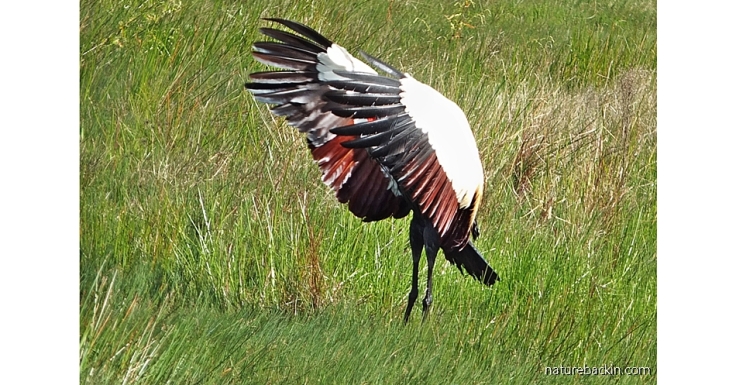
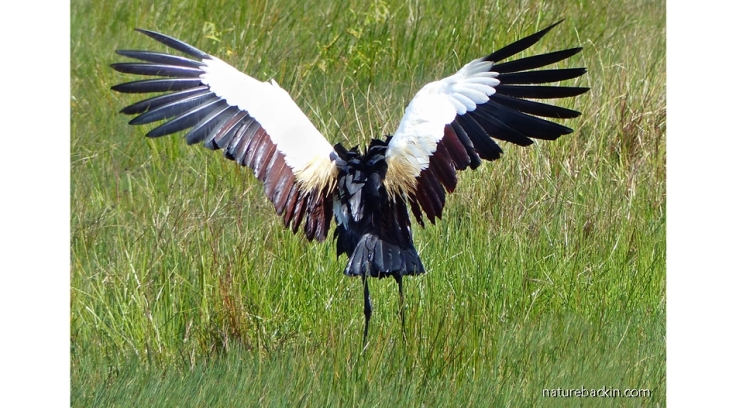
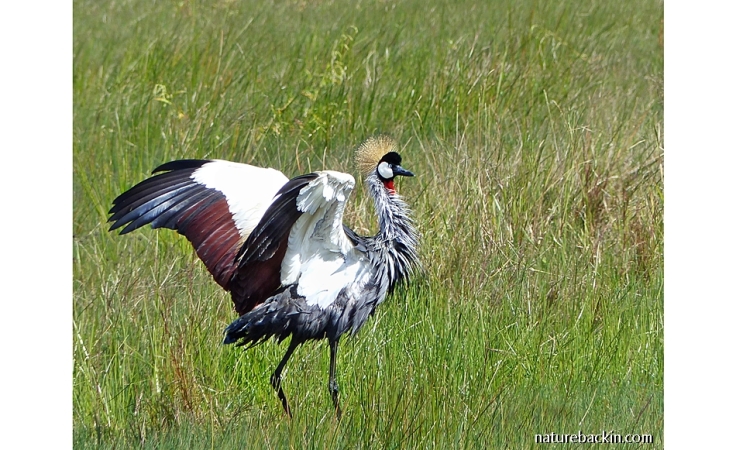
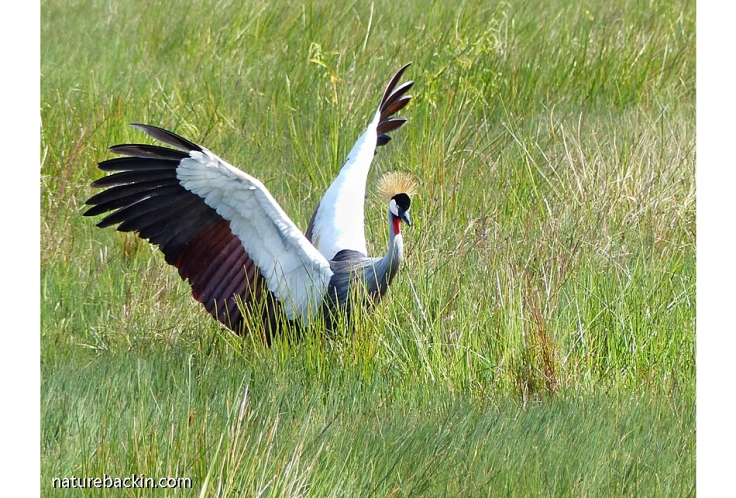
And putting it all together, here is a series of video clips showing parts of the courtship dance.
The video shows the pair calling in duet and displaying, and then an interlude where one of the cranes has a thorough bath followed by a preening session, and then another brief series of wing-spreading and jumping moves, before the pair move off quietly together for a spot of foraging.
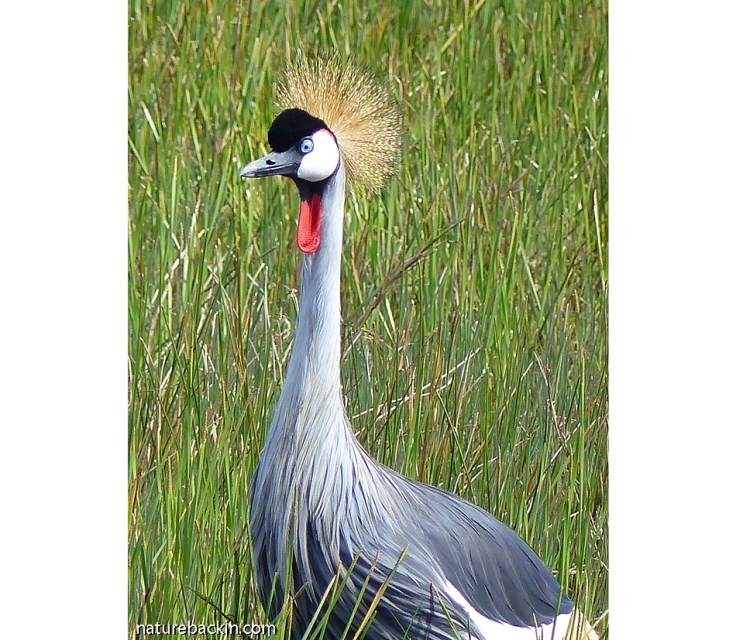
Sources:
Encyclopedia of Life. Balearica regulorum. Grey Crowned Crane http://eol.org/pages/915338/hierarchy_entries/24919546/details; International Crane Foundation https://www.savingcranes.org/; IUCN. 2018. The IUCN Red List of Threatened Species. Version 2018-2. http://www.iucnredlist.org Downloaded on 25 October 2018; KZN Crane Foundation http://kzncrane.co.za/
Posted by Carol

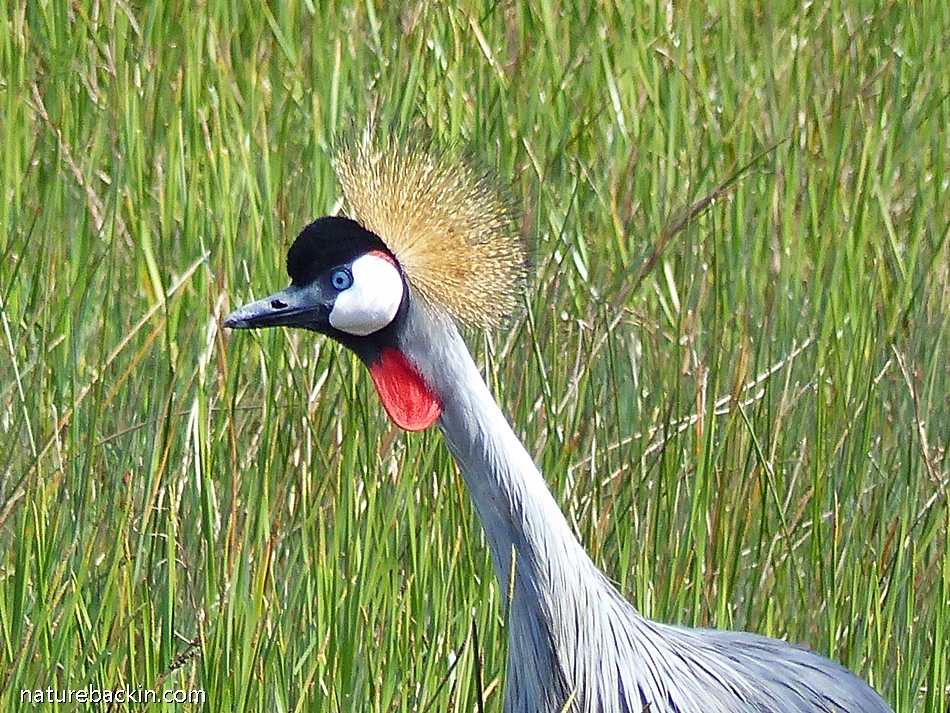







October 29, 2018 at 3:28 am
Loved this post. I’m in awe of these gorgeous cranes. It’s nice to see the effort being made to preserve them. I’ve seen this species in nature programs, but don’t remember having seen the grey crane. I think someone before my comment used the word ‘elegant’ and they truly are. I must say I very much enjoyed the video to see the dancing and jumping and bathing! (Very nice videography there!)
Here on our side of the planet, I’ve seen our sandhill cranes several times, but the endangered whooping cranes are only found in Florida… much too far to travel diagonally across the country (some 3,000+ miles or close to 5,000 km).
LikeLiked by 1 person
October 29, 2018 at 8:58 am
Thanks Gunta, and I agree they are incredibly elegant birds. I think the north American cranes are mostly migratory, which must put them at greater risk. Mind you our more sedentary species are also at risk, sadly. Video can convey what stills cannot, especially the vocalization and action associated with the courtship dance, I don’t often take videos, and so need more practice. I got a bit more wobbly with the camera in one section, but decided to leave it in anyway, as the footage is interesting.
LikeLike
October 27, 2018 at 4:08 am
The only cranes I’ve seen have been at the Hilo zoo so it’s nice to see photos of them in their natural habitat. So glad that the importance of wetlands is not only being recognized, but acted upon also.
LikeLiked by 1 person
October 29, 2018 at 8:42 am
Well at least there are good intentions regarding conserving wetlands, albeit in the face of adversity …
LikeLiked by 1 person
October 27, 2018 at 12:18 am
Fabulous post, Carol. Conserving wetlands and birds is so important and it is only fairly recently that its importance is recognized. I really enjoyed the video, seeing the cranes in action. It must have been so exciting to see them in person.
LikeLiked by 1 person
October 29, 2018 at 8:41 am
Thanks Eliza. I suppose it is better late than never regarding understanding the importance of wetlands! It was unbelievable to see the cranes “performing”. I don’t often take videos, so it was a bit erratic, but the subject matter makes up for that I hope!
LikeLike
October 29, 2018 at 2:51 pm
It was wonderful to see them in action. Seeing it beats any description, esp. the head bobbing!
LikeLiked by 1 person
October 26, 2018 at 9:29 am
So heartening to see some good conservation in action. The crowned cranes are such magnificent birds; that haunting call. I have never seen a blue one, so thank you for including him/her here too.
LikeLiked by 1 person
October 26, 2018 at 6:30 pm
Thanks Tish. Yes it is heartening. They are fantastic birds. The blue one is not as flamboyant but very elegant too.
LikeLiked by 1 person
October 26, 2018 at 7:56 am
Thanks for the informative article, stunning photo’s and video!
LikeLiked by 1 person
October 26, 2018 at 6:29 pm
Thanks so much Suzette. Some of the video was a bit shaky, but I thought that the subject was interesting enough to compensate …
LikeLike
October 26, 2018 at 3:33 am
I would love to see Grey Crowned Cranes again – cannot remember when last I did, it was such a long time ago.
LikeLike
October 26, 2018 at 6:22 pm
Yes, it is so sad that they are so seldom seen these days and that their numbers are declining to the point that they are now endangered.
LikeLike
October 26, 2018 at 2:33 am
Whenever we visit “The Midlands” we always keep a special eye open for the cranes, and the Karkloof Conservancy is one of our favourite spots too.
LikeLiked by 1 person
October 26, 2018 at 6:21 pm
Glad to know you also value this spot in the Karkloof.
LikeLiked by 1 person
October 25, 2018 at 9:04 pm
How privileged you were to see these amazing birds in courtship. I didn’t know about them so I enjoyed seeing all your photos and learning about them. They are so elegant with their tiaras of feathers. They’re really rather large too-must be wonderful to see them in flight.
LikeLiked by 1 person
October 26, 2018 at 6:21 pm
Thanks Jane. Yes it really was a special privilege. They are beautiful to see when flying – they kind of tuck the crown back flat when in flight.
LikeLiked by 1 person
October 25, 2018 at 8:42 pm
Really appreciate the work being done to highlight the importance of setting aside land for conservancies and in protecting wetlands. Your article puts into perspective preserving precious ecosystems and working together across the different disciplines. What a brilliant sighting of the courtship dance of the Grey Crowned cranes. Such elegant looking birds.
LikeLiked by 2 people
October 26, 2018 at 6:18 pm
Yes, it is great when people from different disciplines can work together for shared goals and breach the more usual silos. We were fortunate to see the courtship dance at such close quarters. They are lovely birds. Sad that their numbers are in such decline.
LikeLike
October 25, 2018 at 8:30 pm
Wetlands seem widely to have been disregarded as being important until relatively recently. I was never that interested either. This post shows what we’ve all been missing, and how important they are. Lovely photos as usual.
LikeLiked by 1 person
October 26, 2018 at 6:12 pm
It is somehow surprising that the importance of wetlands was not recognized before, at least by policy makers. Hopefully some of those trends can be reversed.
LikeLiked by 1 person
October 25, 2018 at 8:00 pm
Gorgeous shots! Fantastic experience.
LikeLiked by 1 person
October 26, 2018 at 6:10 pm
Thanks Leya. It was fascinating and we were lucky to see it.
LikeLiked by 1 person